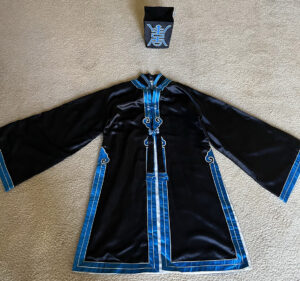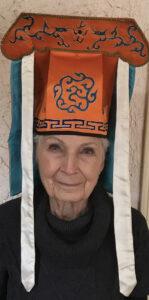 JL traveled the world throughout her life. She sent me a souvenir of the traditional Chinese opera she visited over fifty years ago as a guest of the Chinese Government. I assume JL visited after the death of Mao Zedong, (1967), meaning the Chinese opera that night was a big deal, reserved for dignitaries.
JL traveled the world throughout her life. She sent me a souvenir of the traditional Chinese opera she visited over fifty years ago as a guest of the Chinese Government. I assume JL visited after the death of Mao Zedong, (1967), meaning the Chinese opera that night was a big deal, reserved for dignitaries.
The Cultural Revolution, masterminded by Mao, and Madam Mao and others in the “gang,” established the People’s Republic of China. They aimed at preserving Chinese Communism by purging capitalistic ideas and traditional Chinese hierarchies. In 1964, 2,000 Government specialized opera troupes of fifty to a hundred performers told stories of MANY operas. After 1965 none other than Madame Mao, Jiang Qing, once an actress herself, sanctioned only eight “model operas.” This made JL’s visit to the Opera that night in the 1970s special.
Chinese Opera Longevity
If you think Chinese opera compares to the European style opera, it does NOT, for many reasons. Perhaps the best reason is its longevity. The opera goes back to the dawn of Chinese culture, some say somewhere around the third century when first performed. It combines music, singing, dance, martial arts, acrobatics, elaborate costumes with secret symbolism, and make-up of the highest artistry, not to mention poetry and literature. The artform is so ancient that it MATURED in the 13th century (Song Dynasty 960-1279).
So, when JL attended the Opera in the 1970s it had been around for 2,000 years and one revolution wouldn’t kill it. But it almost did…the Cultural Revolution stuck one knife in the back of Traditional Chinese Opera. The other knife came soon after the performance JL witnessed in the 1970s., The younger generation brought about Modernization, the movement from Chinese art forms to imported art forms.
By the time of JL’s visit young people didn’t go in for opera. They considered it for the old, on the verge of fading. Today, however, it thrives with some of the favorites performed all over China. Each region of China presents its own flavor of Opera, but most considered the Beijing (Peking) Opera as the National Theatre of China. Some of the classic titles are The Poppy Pavilion, The Peach Blossom Fan, Journey to the West, Romance of the Three Kingdoms.
Costume Color Matters
 JL wants to find a home for the costumes and asked me to mention their provenance. In each area of China costumes appear slightly different. Due to the bright colors and embroidery, I suspect JL’s come from the Beijing Opera. However, I do know colors MEAN something nationwide. Costumes indicate social hierarchy, a code to the audience. A certain style of clothing represents a class of people, and they reserve specific costumes for performers. Graceful dancers wear “water sleeves” elongated flowing silk sleeves touching the stage floor, swirling around the body.
JL wants to find a home for the costumes and asked me to mention their provenance. In each area of China costumes appear slightly different. Due to the bright colors and embroidery, I suspect JL’s come from the Beijing Opera. However, I do know colors MEAN something nationwide. Costumes indicate social hierarchy, a code to the audience. A certain style of clothing represents a class of people, and they reserve specific costumes for performers. Graceful dancers wear “water sleeves” elongated flowing silk sleeves touching the stage floor, swirling around the body.
JL visited after the death of Mao when China semi-opened to the West. When the opera ended she went back to the costume department. They invited her to pick out a costume to purchase. She selected a navy-blue silk coat embroidered with royal blue, and a matching tall, squared hat with a plume on top to symbolize fire. Also, she chose a tall yellow-orange squared hat with a drape of orange embroidered silk lined with blue, and two long strips of white silk hanging on either side of the face.
JL’s blue coat represents characteristics of the character. Blue stands for ferocity and courage on one hand and cruelness and violence on the other. Yellow stands for a clever, secretive, mysterious, and evil character.
I estimate the value of the coat as $600 along with the matching hat. The yellow-orange hat falls in a value range of $100-$200.